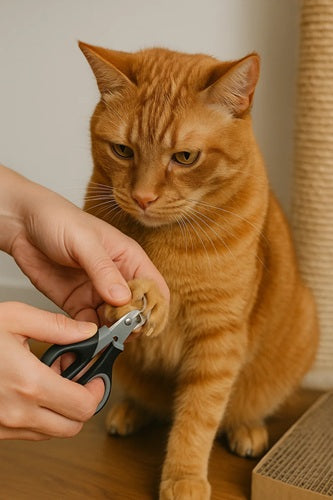How To Groom An Aggressive Cat
Grooming a cat is really important to upkeep the quality of his fur, which in turn affects his health and well-being. While some cats don’t mind getting groomed, others resist grooming vehemently. Irrespective of whether a cat likes it or not, grooming is essential, so the owner/groomer has to take control of the situation in a positive manner and ensure that the cat is properly groomed on a regular basis. In this blog, we will help you understand why some cats get aggressive during grooming and how to get them comfortable.
Why Do Some Cats Resist Grooming?
There could be a variety of reasons that cause your cat to resist a grooming session. Some of the reasons could include:
● Anxiety around strangers● A negative grooming experience in the past.
● Dislikes human touch due to fear of abuse.
● Skittish personality
● Prefers self-grooming
● Not comfortable in a new environment
● Untangling matted fur might be painful
These are some of the reasons your kitty might be aggressive/skittish during a grooming session. It is important, and possible to, work on these reasons and develop positive associations towards grooming.
How to Groom an Aggressive Cat?
In order to help your cat overcome his discomfort, it is important to first identify why he dislikes grooming. By regular and close observation of his behavior you should be able to detect what triggers his discomfort. Once the root cause is identified, it is possible to make modifications in the grooming process to make your kitty more comfortable. Feline behavioral problems should not be ignored. Early intervention helps to avoid issues escalating further.
It is helpful to familiarize your cat with everything related to grooming - the products, environment and even the groomer. This interaction prior to grooming will help familiarize him with the process.
- To begin with, you can lay out the grooming products such as brush, shampoo, nail clippers, etc and allow your cat to sniff or rub against them. This will help your cat ease his fear of the equipment.
- Begin to brush with slow, soft and gentle movements to get your cat used to the feel of the equipment. Brush your cat in multiple short sessions and reward him with a tasty treat every time.
- If the unfamiliar environment of a grooming salon is causing your cat to feel nervous, let him spend some time getting comfortable in the space before starting to groom him.
- A skittish cat would most definitely resist being with a stranger. Therefore, allow the groomer to interact with your cat before grooming him. Some cats would respond positively to familiar faces more than they would to complete strangers.
For some fearful cats, it helps when the pet parent is close and visually accessible to provide comfort and assurance. If you are grooming your cat at home, you can use treats or their favorite toys to help them remain calm. If there are sudden movements it may result in either of you getting hurt.
Cats have certain areas on their body that are sensitive to touch which is why they recoil when they are touched there. For example, many cats don’t like being touched on their belly. On the other hand, cats love being stroked on their head. It is beneficial to use this information when working with nervous or aggressive cats. By starting with a few strokes of the brush on the head and cheek areas you are able to make them a bit more comfortable before proceeding onwards to other parts of their body. If your cat is enjoying these movements around the head, move towards the shoulder and neck. After the cat becomes relaxed and drowsy with head strokes, it is time to brush the belly. Do so in short movements as this might help him feel in control of the situation.
Some cats aren’t particularly fond of water so bath time can be quite the challenge. Keep all your requirements ready before bath time, you don’t want to start the bath only to realize that you have missed something. Begin by wetting your cat’s coat thoroughly with warm water, try to avoid getting water in his eyes or ears. Shampoo his coat from neck down and gently massage his body. Many cats enjoy massages so a good massage during bath time can help make your cat get used to water. Slow and calm movements are advised, sudden movements can cause him to be on alert. Use a soothing, calm voice to comfort him during the process. For cats that have a thick fur, spend adequate time on each step to ensure a thorough clean. While rinsing, you might have to repeat two or three times till their coat is lather free and clean.
Tips:
- If your cat does not let you brush a certain area, you shouldn’t force it.
- Try to go at your cat’s pace, no matter how slow. It would gain their trust and allow them to see that you mean well
- Trim your cat’s claws a day or two prior to avoid getting scratched
- Visit a groomer if you find it difficult to groom your cat at home.
- When grooming your cat be calm and composed, your impatience could cause him to become more aggressive
- Consult a veterinary behaviorist if you cannot understand your cat’s aggressiveness.
Adapting to getting groomed by humans is a challenge for some cats. But over time, grooming your cat can become a positive experience. Being patient is the key, especially when your cat is aggressive. Hang in there.








